“The Most celebrated science fiction and fantasy writer of her generation.” – The New York Times
N(ora). K. Jemisin is a New York Times-bestselling author of speculative fiction short stories and novels, who lives and writes in Brooklyn, NY. In 2018, she became the first author to win three Best Novel Hugos in a row. She has also won a Nebula Award, two Locus Awards, and is a recipient of the MacArthur “Genius” Fellowship. In addition to writing, she has been a counseling psychologist and educator, a hiker and biker, and a political/feminist/anti-racist blogger.
N. K. Jemisin’s session is by far one of the best masterclass session have seen on the materclass.com platform. I have seen almost all the writers on the platform: Dan Brown, James Patterson, Neil Gaiman, Malcolm Gladwell, Margaret Atwood, Shonda Rhime, David Baldacci, Joyce Carol Oates, Judy Blume, R.L.Stine, Bob Woodward, Roxanne Gay, Salman Rushdie, Walter Mosley.
“Fiction is about making it feel right, Worldbuilding is an act of exploration, and the better equipped you are, the farther you can go.”
Growing Up
Born Nora Keita Jemisin in Iowa and raised between New York City and Mobile, Alabama, she spent her childhood in motion—strolling around Brooklyn with her father, camping in the Catskills, and visiting Iowa, Chicago, and Paris, she was bombarded with intriguing sights and sounds, all of which she eagerly absorbed.
Voracious Reader
Even when she was rooted in one place, N. K. found other conduits to continue this immersion: books. Science fiction and fantasy became her favorite refuges, exposing her to dynamic new environments and daring storytelling. She was so bewitched by the genres, in fact, that she began to sneakily read books during class. By age eight, N. K. had also “started writing about talking animals and the apocalypse,” as she explained in her 2013 essay “How Long ’Til Black Future Month?”.
Getting Started
After a premature “midlife crisis” at age 30, N. K. started to reap the rewards of the effort and focus she put into her writing. By the mid-2000s, she had one of her short stories, “Cloud Dragon Skies,” published in the speculative fiction magazine Strange Horizons, and she landed an agent thanks to an early manuscript for her novel The Killing Moon.
Writing Career
She began an ascent from anonymity to working as a book reviewer (she would contribute a column, Otherworldly, for The New York Times Book Review from 2016 to 2018) and teaching other writers at workshops.
Inheritance Trilogy
In 2010, Orbit Books published N. K.’s The Hundred Thousand Kingdoms, an epic fantasy about a young outcast who inherits a powerful kingdom and becomes embroiled in a fierce power struggle. It was the first installment in what would become the Inheritance Trilogy, a powerhouse series that launched her into the modern science fiction canon.
In the years since, N. K.’s expansive body of work has included short stories, novels, novellas, and comic books.
Awards
In 2016, N. K. won her first Hugo Award, considered speculative fiction’s highest honor, for The Fifth Season, the first volume in her Broken Earth Trilogy. She would go on to win three more Hugos (including a consecutive three-peat, from 2016 to 2018, for each book in her Broken Earth Trilogy) and be nominated a total of seven times.
Writing Routine
I do not recommend that anyone follow another author’s writing routines— that’s a fantastic way to increase anxiety.
When I’m really in a groove, I do about 1,500 words per day. When I’m in deadline mode, I do 3,000 words per day. I do not write every day. If I’m sick, tired, stressed about other things, or otherwise just not in a good headspace, I’ve found that it’s more valuable to not write that day than write badly (which I’ll then have to spend extra time fixing or deleting-and-replacing with better writing)
The Drafts – The Zero Draft
I write a “zeroeth draft” first. That’s the one that will never be seen by anyone but me. It has [brackets] all over the place where I’ve included notes to myself like [fact-check this] or [can’t remember the word I need here]. It often has no chapter titles, numbers, or epigraphs, because I know I might need to reorder chapters of the story; sometimes it’s got giant plot holes in it.
Element X
At the heart of every fantastical story, be it the coming-of-age of a rebel like The Hunger Games’s Katniss Everdeen or the space-borne escapades of a bounty hunter like Cowboy Bebop’s Spike Spiegel, is a “What if…” question that establishes some foundational oddity. This premise binds the narrative together, defining what is possible in a story and shaping what can (and does) happen.
N. K. describes this core component as “Element X,” a name that conveys both how elemental and limitless this centerpiece can be, A good Element X is scalable and distinctive: The Force in Star Wars, for instance, has all kinds of uses. For the Jedi and Sith, it’s a weapon, a means of persuasion, and a way of manipulating the physical environment, in addition to a spiritual experience. For the many people who cannot use the Force, it is a privilege, and Force users are kind of culty. Put differently, the Force is a means of marking the various social, individual, and religious differences among the galaxy’s many characters.
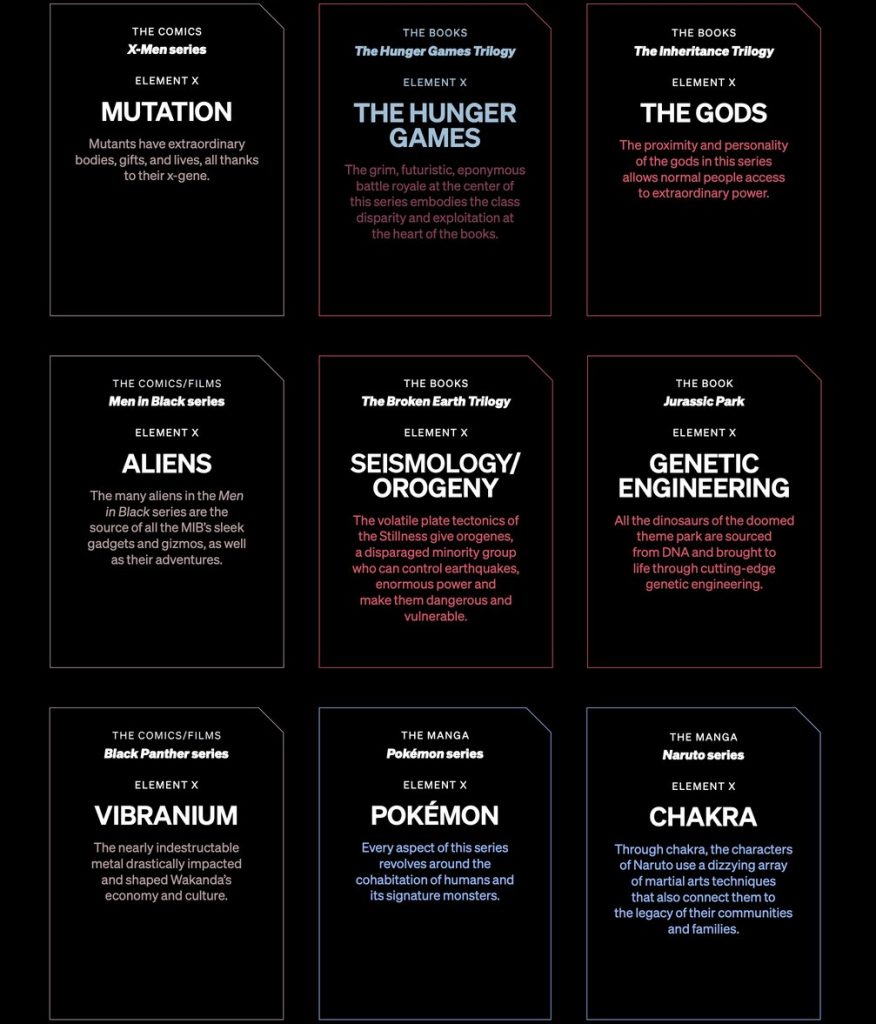
Whatever your Element X is, it doesn’t have to do everything that the Force does—nor should it. But the more modular your element, the more ingrained it is in the dynamics of a world, and the more unique your story can be. Here you can find a sample of some Element X plot points that power popular stories. Note how series with the same Element X can still radically differ depending on how the element is used or whom the main character is.
Your fictional world is a context, not a contract. As you refine your narrative, embrace revisions.
Melt the Iceberg
How you can strike the right balance between revealing too much and sharing too little.
Iceberg theory is a worldbuilding rule that emphasizes concision and functionality. Like an iceberg, the theory declares, 90 percent of a fictional world should be invisible; your reader should see only the 10 percent that’s floating above the surface. That way, the narrative will not be leaden with information, a faux pas known as infodumping (i.e., if you’ve ever read a book and thought, “This is a slog”).
The theory can be useful for focusing your story or novel and can help you streamline your storytelling, making it fluid and seamless. But beware: Following iceberg theory can also be risky and possibly prohibitive. The metaphor is ominous— icebergs sink ships—as well as dismissive and misleading.
A story that is too slick and quick-moving can be just as alienating as one that is dense with information
Point of View Hierarchy
Low Immersion: Third Person Omniscient
In the “Distant” 3rd person, multiple Point of View (POV) Omniscient narration, you know the character thoughts and actions. The narrator is telling you everything that is going on and telling it like they are telling a story.
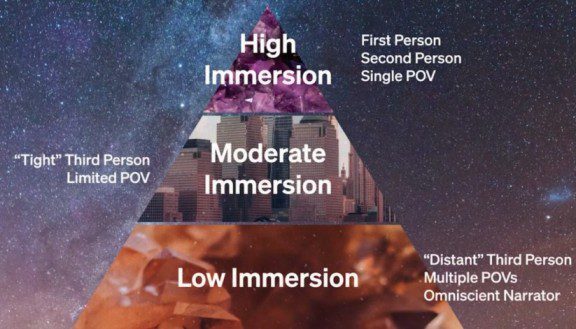
Moderate Immersion “Tight” Third Person Limited POV
You are going to know what is the characters head unless you are in the characters narration.
High Immersion – First Person, Second Person, Single POV
You are going through that story as if you are the character. First person usually, not
The Hierarchy of Characterization
For N. K., crafting compelling characters means tapping into her background in psychology—specifically Maslow’s hierarchy of needs, a motivational theory proposed by psychologist Abraham Maslow in the 1940s. Presented as a pyramid chart, the base of the pyramid represents
the most fundamental, physiological needs we all require to survive: things like food, water, and shelter. Less physical or tangible needs like security, intimate relationships, esteem, and achieving one’s full potential appear progressively higher up the pyramid.
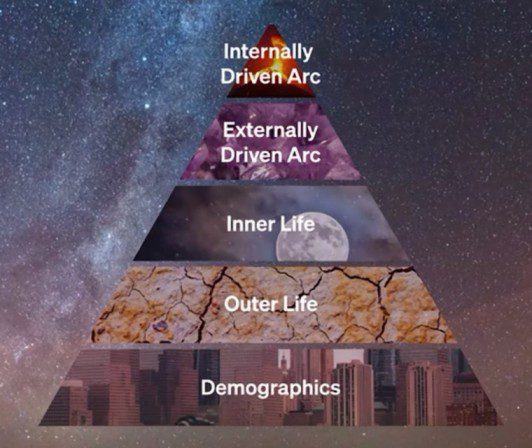
When she’s creating a character, N. K. uses Maslow’s pyramid idea to flesh out said character’s outer and inner life. At the bottom of her pyramid, N. K. says she starts “with the basics about a person—their demographics, their age, their race, their gender—all of the simple things that you can know from glancing at a person or that a writer can do a one-line description of and a reader will know
all about it.” Next, she moves into things “that are a little less visible,” things that make up a person’s outer life but are not immediately apparent. These might include a person’s accent, their clothing, how they present themselves—all clues to a larger story about a person’s role in society, their
class, or their background.
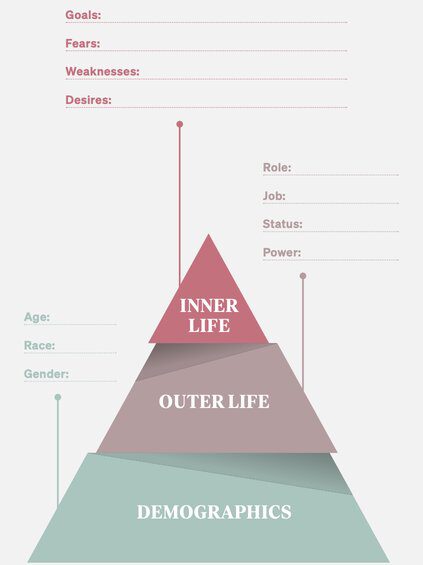
The most popular and cutting-edge way to tell stories is to tell the stories of people who aren’t the rugged individualists.
Finally, closer to the top of the pyramid will be the inner life of N. K.’s character—those things that, as she says, a person wouldn’t know “without speaking to [the character] or being related to them or living with them…things like their goals, their wishes, their fears, their weaknesses, things that make them a more complex person.”
Rugged Individualist
One of the most often-used archetypes that has long permeated literature (and film, TV, theater…everything) is the “rugged individualist.” Usually white, heterosexual, able-bodied, and male, this archetype can describe everyone from Indiana Jones to Mad Max to, as N. K. points out, every John Wayne character ever As she says, stories featuring the rugged individualist center on “a person overcoming adversity just by being super tough and super interesting and super powerful.
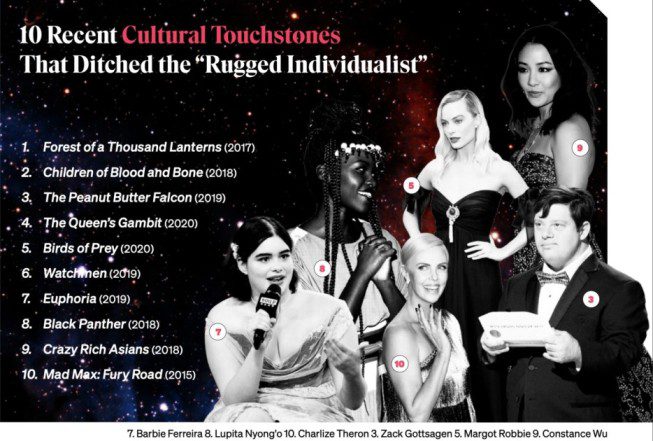
The “rugged individualist” is an overused (and limiting) trope. When you’re writing, consider how you can create fresh archetypes. The most popular and cutting-edge way to tell stories is to tell the stories of people who aren’t the rugged individualists. You can still include a rugged individualist character in there if you’d like, she adds, but taking a cue from 2015’s Mad Max: Fury Road movie, consider reimagining the role they can play in your story: Instead of a protagonist, turn them into a sidekick.
Celebrating Rejection – Writing Groups
Writing groups can also help you commiserate. As N. K. recounts, “When I was a beginning writer, the writing group that I was in actually celebrated rejections. Every 50 rejections, we would all go out and have a party. When we had a hundred rejections, we all decided to go out for drinks. At 150, I think we hit a strip club. I don’t know that that’s necessarily the way you want to celebrate, but celebrate those rejections because they are very much a part of being a writer, and they are going to help you become the writer that you ultimately want to be.”
Surviving the Publishing Industry
Most writers moonlight, meaning they do not exclusively work as writers.
Ted Chiang, for instance, who is famous for his short stories and has never published a novel, writes technical manuals for a living.
Satirist Paul Beatty and essayist Eula Biss are college professors.
The late Toni Morrison spent much of her career as an editor in the publishing industry.
Comic book artist Christopher Priest is an ordained minister. Ta-Nehisi Coates was a journalist before he became a novelist.
The key to making your way through this dense forest of options and opportunities is to know your goals and familiarize yourself with how best to achieve them.
Recommended Books
- Writing the Other by Cynthia Ward and Nisi Shawl
- Self-Editing for Fiction Writers, Second Edition: How to Edit Yourself Into Print by Renni Browne and, Dave King
- The Unreal and the Real: The Selected Short Stories of Ursula K. Le Guin
- The Lord of the Rings
- Wraeththu series by Storm Constantine
Resources:
- Publishers Weekly
- Poets & Writers
- Duotrope
- Science Fiction & Fantasy Writers of America’s “Writer Beware” section
- QueryTracker
- The New York Times Book Review
- Bookforum
- Catapult
- Variable Paradise Writing Workshop
- Online Self-Protection – Crash Override
MasterClass is a streaming platform that makes it possible for anyone to learn from the very best. MasterClass is an online membership – accessible on your phone, web, Apple TV, Roku devices, and Amazon Fire TV – that offers classes on a wide variety of topics taught by 90+ world-class masters at the top of their fields.
Their immersive learning experiences combine incredible video content, downloadable materials, and social interaction with the MasterClass community, all of which users can explore at their own pace.
The annual membership is available for $180 USD, which allows unlimited access to ALL on demand MasterClass content for the year.
Give One Annual Membership. Get One Free.
All the best in your quest to get better. Don’t Settle: Live with Passion.
For More Information: MasterClass Home Page
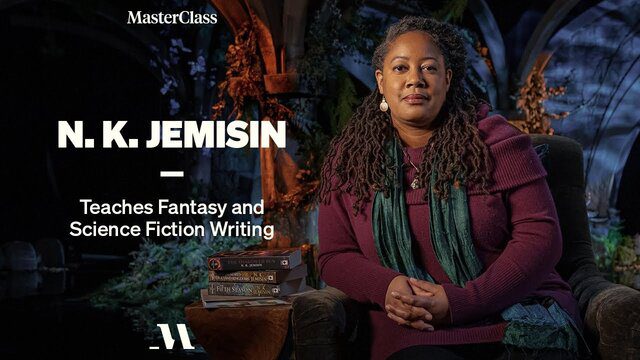


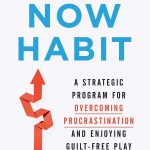
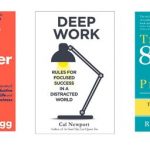
Comments are closed.